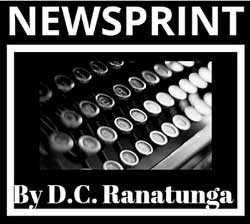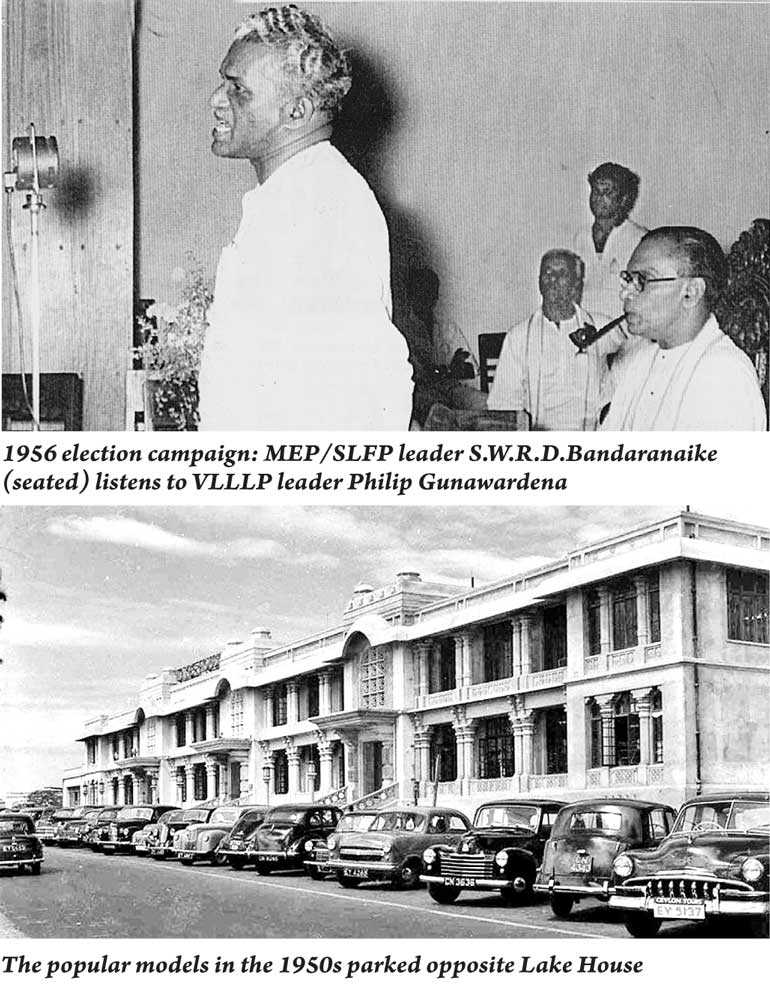Tuesday Mar 18, 2025
Tuesday Mar 18, 2025
Saturday, 5 January 2019 00:00 - - {{hitsCtrl.values.hits}}

April 1956 was a decisive month for Ceylon – as Sri Lanka was then known. The United National Party (UNP) which administered the country for nine years at a stretch from 1947 was ousted by the Mahajana Eksath Peramuna (MEP) – a coalition of the Sri Lanka Freedom Party (SLFP) led by S.W.R.D. Bandaranaike, Philip Gunawardena’s Viplalakari Lanka Sama Samaja Party (VLSSP) and veteran politician W. Dahanayake’s Bhasha Peramuna – at the General Election held that month. Bandaranaike was sworn in as Prime Minister on 12 April along with a 13-member Cabinet.
The month also marked the end of my university studies when I sat the final examination having completed three years at the Peradeniya campus. The general election was held in the midst of our exam and we – the inmates of Jayatilaka Hall – were jubilant when the first result was announced. Irrespective of party affiliations, it was because our Hall mate Nimal Karunatilleka had won the Matale seat on the MEP ticket. We celebrated with a good sing-song in the common room late at night.
Once the final exam was over we had to face the next hurdle – finding a job. Joining the public service as a teacher or a labour inspector was not much of a problem. The starting salary of a teacher was Rs. 185 per month plus cost of living allowance. There was an added attraction in joining the Labour Department – getting a loan to buy a car since the job involved travelling. I wasn’t much keen on either of the two jobs.
Having relaxed for a week or two enjoying ‘buth curry’ at home and getting up late in the morning, it was time to look round for a job. I thought of trying my luck with the ‘Dinamina’ where I had worked for a few months pending university entrance results. That was in early 1953.When I saw an advertisement in the ‘Daily News’ for trainee journalists, I sent an application and was called for an interview. Those selected were to be attached to the ‘Dinamina’.
There was a written test and an interview. Four or five of us were selected and we were taken one by one to meet the Managing Director (Editorial), Esmond Wickremasinghe. The first thing he told me was that I would leave no sooner the results come. I responded by saying that having failed the previous year I had no hopes of getting through. I got the job. A few months later when the results came I had passed and I quit. I enjoyed my short stint and got a liking towards journalism.
When I walked into Lake House after I returned from Peradeniya my former boss, M.A. de Silva was still the Managing Editor of the Dinamina. He promptly agreed to take me on a temporary basis and I started work as a reporter on 16 May.
The Chief Editor was Piyasena Nissanka (‘Baasuru’ was his pen-name) who was one of the pioneer Sinhala journalists who joined Lake House in 1918, four years after D.R. Wijewardene bought the ‘Dinamina’ which was started by H.S. Perera. The elderly gentleman, whom we addressed as ‘Loku Sir,’ had by then completed nearly 40 years of continuous service.
“Nissanka occupied the Dinamina editorial chair longer than any of his predecessors and saw the paper making giant strides in circulation,” wrote his contemporary, ‘Daily News’ Editor H.A.J. Hulugalle, in ‘The Life and Times of D.R. Wijewardene’ (1960).

Being on the verge of retirement he was not very active apart from writing the second editorial in a somewhat lighter vein. It was pretty interesting reading. We enjoyed him singing folk songs whenever he felt rather lazy. ‘Hath dawasakma magul keva kukul kakul’ was one of his favourite songs. Whenever we found the time we used go to his room and have a chat about early days, being a typical village type (his birth-place was Kandeliyadda paaluwa – a few miles off Kadawatha into the interior).
Competition
 By early 1950s the ‘Dinamina’ was facing stiff competition from the ‘Lankadeepa,’ the Sinhala morning daily that the Times of Ceylon group started. Its Founder Editor was the reputed scholar Julius de Lanerolle with D.B. Dhanapala as his able assistant.
By early 1950s the ‘Dinamina’ was facing stiff competition from the ‘Lankadeepa,’ the Sinhala morning daily that the Times of Ceylon group started. Its Founder Editor was the reputed scholar Julius de Lanerolle with D.B. Dhanapala as his able assistant.
In a restructure to meet the challenge from the ‘Lankadeepa’, M.A. de Silva – a contemporary of Esmond W in the university who had joined the Daily News, had been appointed Managing Editor and D.F. Kariyakarawana had moved over from the ‘Lankadeepa’ as Chief Sub-Editor. University graduates were being recruited to strengthen the editorial staff.
When the ‘Dinamina’ enjoyed being the only Sinhala morning daily, it was the practice to depend on the morning English daily, the ‘Daily News’ for news. The ‘Daily News’ reporters had to give the ‘Dinamina’ a carbon copy of every report they typed. (Computers were unknown then.) They were then translated and used.
By the time I joined in 1956 there was a team of reporters exclusively for the ‘Dinamina’. It had been realised that the readers should be given news which would interest them rather than just translating what the English readers were given. Hence a separate news desk.
An excellent reporter with an eye for news, Pujitha Wijetunga was heading the News Desk. He assigned the other reporters to cover the day-to-day news, guided the reporters and checked the news stories which they wrote before passing over for publication. The reporters wore shirt and tie and Pujitha donned a coat as well. He used to be in and out of Parliament where he made contact with a number of MPs – both Government and Opposition. (Loku Sir and M.A. de S were the other Dinamina staffers who wore a ‘full suit’.) The reporters were allotted ministries and Government departments to hunt for news. They found that wearing a tie gave them recognition and they were well received by the officials.
Discover Kapruka, the leading online shopping platform in Sri Lanka, where you can conveniently send Gifts and Flowers to your loved ones for any event including Valentine ’s Day. Explore a wide range of popular Shopping Categories on Kapruka, including Toys, Groceries, Electronics, Birthday Cakes, Fruits, Chocolates, Flower Bouquets, Clothing, Watches, Lingerie, Gift Sets and Jewellery. Also if you’re interested in selling with Kapruka, Partner Central by Kapruka is the best solution to start with. Moreover, through Kapruka Global Shop, you can also enjoy the convenience of purchasing products from renowned platforms like Amazon and eBay and have them delivered to Sri Lanka.
Discover Kapruka, the leading online shopping platform in Sri Lanka, where you can conveniently send Gifts and Flowers to your loved ones for any event including Valentine ’s Day. Explore a wide range of popular Shopping Categories on Kapruka, including Toys, Groceries, Electronics, Birthday Cakes, Fruits, Chocolates, Flower Bouquets, Clothing, Watches, Lingerie, Gift Sets and Jewellery. Also if you’re interested in selling with Kapruka, Partner Central by Kapruka is the best solution to start with. Moreover, through Kapruka Global Shop, you can also enjoy the convenience of purchasing products from renowned platforms like Amazon and eBay and have them delivered to Sri Lanka.